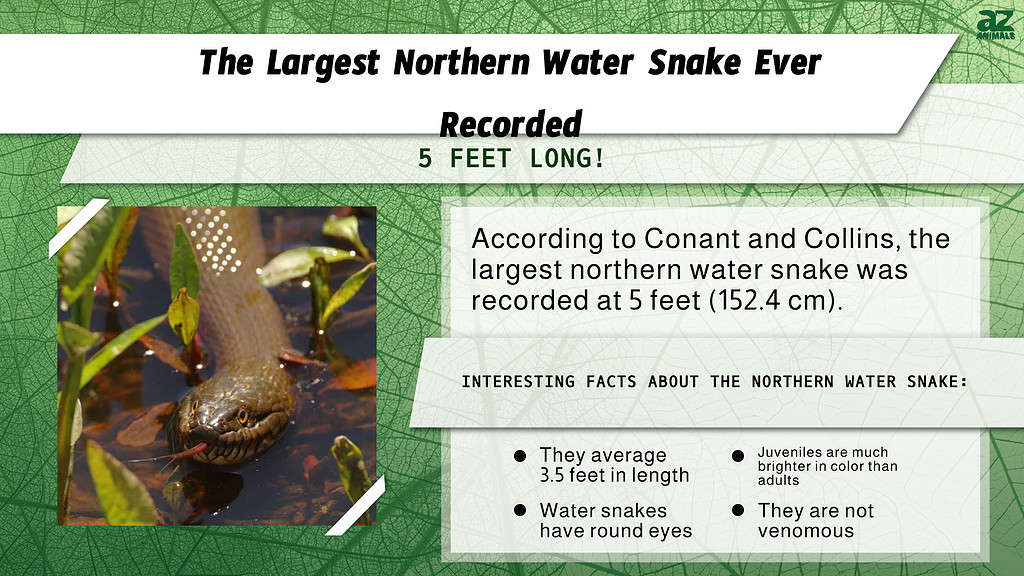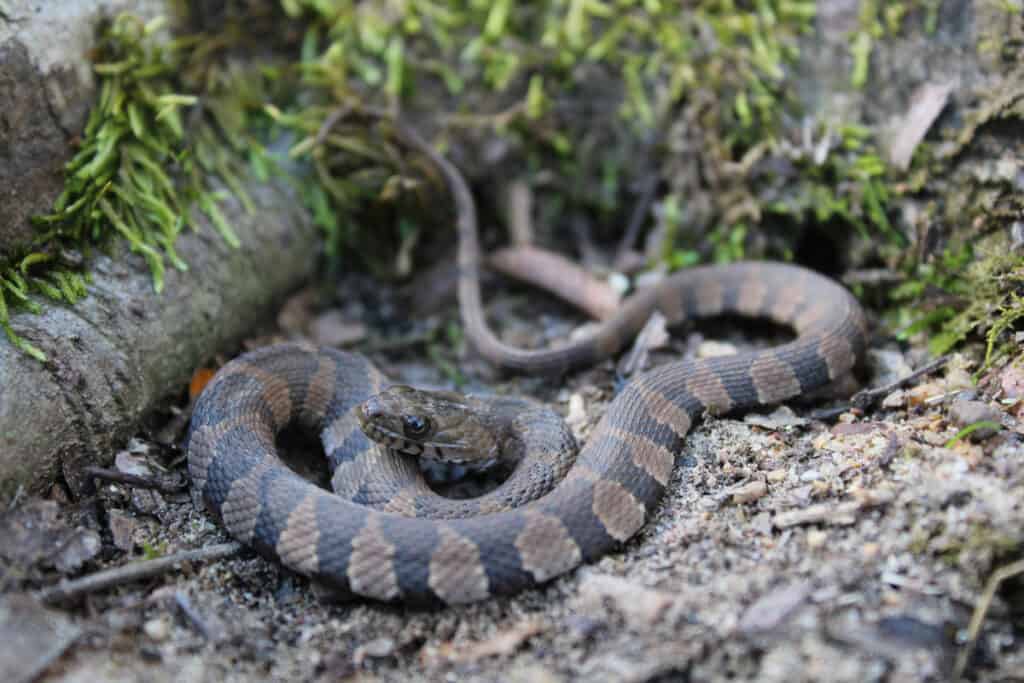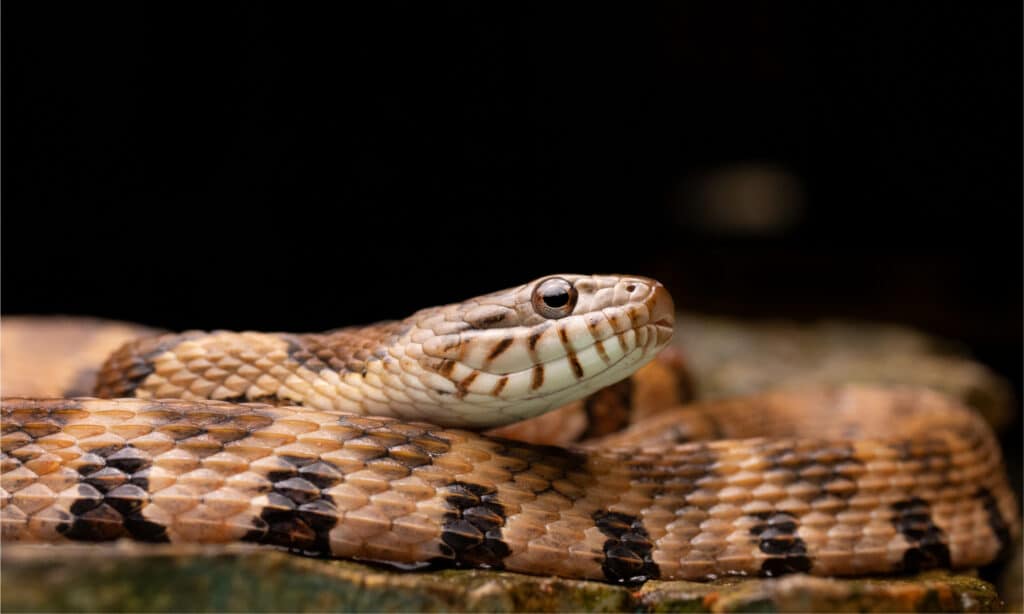
Water snakes are one of about 200 species of semi-aquatic snakes of the family Colubridae, all native to North America. True to their name, they spend most of their lives in or near water. A subspecies of the common water snake, the northern water snake is the most prevalent species of water snake in the United States.
They are harmless snakes but are usually killed unnecessarily out of fear because of their close resemblance to the venomous cottonmouth snake also seen near water. Northern water snakes are quite large and heavy-bodied, measuring about 2 to 4 feet on average. Interestingly, some specimens have been seen to grow bigger than this.
In this article, you will discover the largest northern water snake ever recorded in the world!
Types of Common Water Snakes
There are four recognized subspecies of common water snakes in the United States.
They are:
- Northern watersnake (N. s. sipedon): The most common species, found throughout eastern and central North America. This species can be found throughout the eastern half of the United States, especially in the Northeast and Midwest regions.
- Lake Erie watersnake (N. s. insularum): Found only on a few islands in Lake Erie, Ontario. Its distribution is limited to islands on the western end of Lake Erie, including the shorelines of Pelee Island.
- Midland watersnake (N. s. pleuralis): Endemic to North America. Found in the central and southern United States.
- Carolina watersnake (N. s. williamengelsi): Found in South and NorthCarolina.
How Big Do Northern Water Snakes Get?

The midland water snake can be found in a small section of the Florida panhandle
©Tucker Heptinstall/Shutterstock.com
Fully grown northern water snakes range between 2 and 4.5 feet (0.6 and 1.4 meters) long, with most measuring an average of 3.5 feet long. According to studies, adult females tend to be larger than adult males.
Speaking of female northern water snakes being a bit bigger than male species, the largest females can weigh up to 560 g (20 oz), while the largest males can measure up to 370 g (13 oz).
What is the Largest Water Snake Ever Recorded?

The largest northern water snake recorded measured 5 feet in length.
©jmarino/Shutterstock.com
Conant and Collins reported a maximum body size for a northern water snake at almost 5 feet (152.4 cm)! This is the largest known water snake recorded.
How to Identify a Northern Water Snake
Northern water snakes are moderately-sized reptiles with a few key identifying features. Coloration is highly variable depending on the species. They are relatively dark-colored snakes and may be varying shades of brown, tan, or grayish. However, this species has a special characteristic where it becomes harder to see its color when its scales dry. On the other hand, wet specimens appear brighter in color.
Juvenile snakes are also much brighter in color compared to adults, although as they age, they can become almost completely black. Northern water snakes are stout-bodied, with the head well-defined from the neck region.
They have a series of alternating blotches on their back and sides that may merge to form dark bands. In addition, they are characterized by strongly keeled scales and triangular-shaped heads. The belly or underside is white, yellow, or gray, with dark crescents (half-moon shaped).
Northern water snakes are often mistaken for the venomous cottonmouth water moccasin because they both share similar shapes and colorations. But it is important to recognize that cottonmouths have bands instead of blotches. Another reliable way to tell them apart is by their heads and eyes. Cottonmouths have the characteristic elliptical-shaped pupils (cat eyes) and heat-sensitive pits on their faces, while water snakes have round eyes and no pits.
Where Do Northern Water Snakes Live?
Just as their name implies, these snakes are frequently found near water. Do you know that a northern water snake can stay underwater for about an hour and a half without coming up for air?!
This species lives in a wide variety of aquatic habitats including streams, lakes, ponds, marshes, rivers, as well as wetlands. Juveniles of this species, however, prefer to inhabit lower-order streams. This helps them avoid predators present in large bodies of water (like fish and turtles).
The northern water snake is frequently seen basking on rocks, branches, or stumps, both during the day and at night. Because of this, they prefer to dwell in relatively still, slow-moving waters near places where they can bask in the sun to stay warm. However, any slight disturbance or threat will make them quickly retreat into the water and swim away.
What Do Water Snakes Eat?

Northern water snakes primarily eat fish and amphibians.
©Radiant Reptilia/Shutterstock.com
Water snakes are scavengers and carnivores that eat a wide variety of prey items. Northern water snakes are known to swallow their prey alive, using their senses of smell and sight to hunt. The primary diet of water snakes is made up heavily of fish and amphibians.
They have also been recorded eating some species of frogs, toads, and tadpoles. These snakes are also known to eat worms, salamanders, leeches, crayfish, and several small fish, birds, and mammals.
Do Northern Water Snakes Have Any Predators?
The northern water snake falls prey to many animals, including mammals, birds, large fishes, foxes, skunks, raccoons, and turtles. It is also preyed on by other snakes such as the eastern rat snake and northern black racer.
Humans are its larger predators, though this snake can become fierce and aggressive when attacked by humans. They also release a foul-smelling musk from glands at the base of their tail, and may sometimes release excrement to discourage predators.
Do Northern Water Snakes Bite?
Water snakes bite but are generally non-venomous species. They are not considered dangerous to humans. Yet, when threatened or captured, these snakes are known to flatten their bodies and bite! The northern water snake will defend itself by biting repeatedly.
Larger individuals are known to inflict painful bites on victims. Their saliva contains a substance that inhibits blood coagulation, which can cause the bite to bleed more profusely. However, this poses a limited risk to humans as the possibility of fatality is extremely low, or perhaps nonexistent.
What to do When Bitten by a Northern Water Snake?
Bites by northern water snakes are not expected to cause medically significant effects because they don’t produce any fatal venom. So, if you suspect that you’ve been bitten by a northern water snake, seek the right first aid treatment, according to Clinical Toxinology Resources.
Remain calm until you’re seen by a medical professional to check for infection and your tetanus immune status. It is always advisable to seek medical care as quickly as possible if you develop local symptoms that may suggest a secondary infection.
Other Record-Breaking Snakes
The faded snake, also known as the glossy snake, is a slender ground-dwelling species of snake that can be found in a variety of habitats across the Western United States. These snakes typically grow to be around three feet long, with some specimens reaching up to four feet in length.
However, there have been rare instances where these snakes have grown to be much larger, with the largest glossy snake ever discovered measuring a whopping 70 inches, or nearly six feet, in length.
This is an abnormally large size for these snakes, which are typically known for their slender build. Despite their impressive length, even the largest faded snakes are relatively lightweight, weighing in under two pounds on average.
The photo featured at the top of this post is © iStock.com/IcemanJ
Discover the "Monster" Snake 5X Bigger than an Anaconda
Every day A-Z Animals sends out some of the most incredible facts in the world from our free newsletter. Want to discover the 10 most beautiful snakes in the world, a "snake island" where you're never more than 3 feet from danger, or a "monster" snake 5X larger than an anaconda? Then sign up right now and you'll start receiving our daily newsletter absolutely free.
Thank you for reading! Have some feedback for us? Contact the AZ Animals editorial team.







